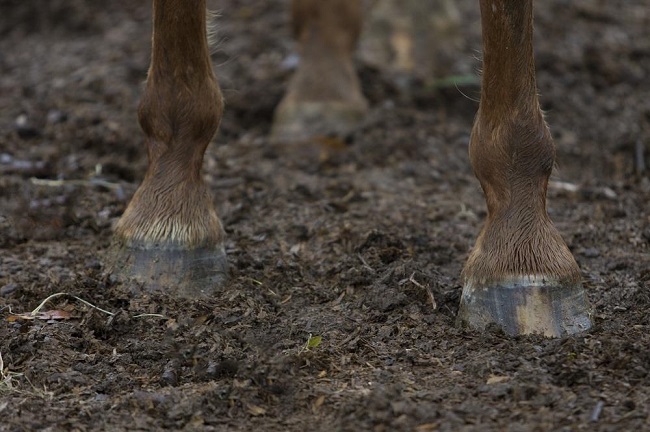
I believe the most hostile environment for our horse’s feet is upon us. Mud season and the excess moisture it brings weaken our horse’s hooves, as well as create the perfect environment for fungal infections. I have seen far more damage to horse’s feet because of extended periods of moisture than I have from being in an extended dry period. A horse’s hooves are designed to regulate the moisture content of the hoof and can do so effectively given the horse lives in a relatively dry environment.
This sounds a bit unrealistic for April in the Northeast and realistically most of us are not going to be able to provide that type of environment. Owners must be willing to make some changes to minimize the amount of time your horse is in the mud and muck. These changes may include alternating pastures, fencing off deep mud, stalling the horse part of the day or even laying down fill in high traffic areas like gates. I know, sounds like a pain, but remember the longer the horse is in the mud, the more moisture the hoof absorbs, the softer the hoof becomes. Soft feet are weak feet. Soft feet will be more likely to flare, crack, bruise, get thrush and the horse can be tender footed when ridden.
In addition to minimizing your horse’s time in the mud, there are some other steps you can take to help maintain your horse’s hoof integrity. First, avoid hoof dressings, while this may seem like common sense many dressings make claims that will tempt you to use them when seeing the negative effects of the mud on your horse’s feet. There are some sealants which may benefit your horse. Such products resemble polyurethane and seal the hoof wall. Iodine based hoof hardeners can also be applied to sole of the horse to counteract the effects of the mud. While they may help, there are no magic potions, and nothing can replace getting your horse out of the muck.
Besides soft feet, this time of year is when thrush rears its ugly head. Thrush is an anaerobic fungal infection of the frog and thrives in a warm, moist, and anaerobic environment. Preventing thrush is far easier than treating thrush, so don’t wait. Regularly picking your horse’s feet robs the fungi of the anaerobic environment it craves, and it also betters your chances of catching it early, so if it does develop it’s easier to eliminate. Applying a thrush treatment proactively can also be effective, so long as it does not harm healthy tissue. Many thrush treatments on the market today are formulated with this goal and are labeled accordingly. Save the bleach for the laundry, it will kill healthy tissue and you will end up with thrush.
How do know if thrush is present? When picking your horse’s feet, you will notice a black, sticky substance in the crevasses of the frog and you will notice a very distinct, pungent odor. If you notice tenderness when picking the feet, bleeding, or large sections of the frog missing contact your veterinarian and farrier ASAP. An advanced case of thrush can be a serious condition if left untreated or if it’s treated improperly. I suggest treating thrush with the same medication used to treat mastitis in cows. Most farm supply stores carry the product. It comes in a tube and is usually sold by the box. It’s relatively inexpensive and works very well. I know, spring brings myriad of chores to do. When prioritizing your chores, consider the ones that will affect your horse’s health. Getting the blankets cleaned will not prevent lameness but taking some time to modify your horse’s turnout or pick his feet will yield a healthier horse to ride when the chores are finally done.
Contributed by Joseph Skipp, Waterford, New York.
Related Articles & Free Email Newsletter Sign Up
Horse Training for Napping Horses
How to Deal with a Horse That has Rolled into a Cast Position


Comment here